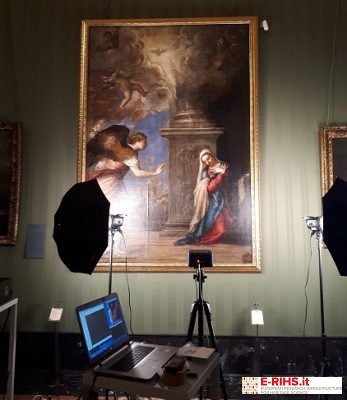
LABORATORY: SMAArt UNIPG
NAME OF THE INSTRUMENT
Portable Visible Hyper-Spectral Imaging System (VIS) (Surface Optics SOC710-VP Hyperspectral Imager)
GENERAL DESCRIPTION
Hyper-spectral imaging is based on reflection spectroscopy that allows you to collect both the reflected and emitted light from a suitably illuminated surface, allowing the collection of spectra from every point of the visual field. The obtained cube, which constitutes the hyper-spectral image, contains both the spectra (of reflectance or fluorescence) and the spatial distribution of different materials on the analyzed surface.
The integrated scanning system characterizes this tool which can record the image and spectra directly from a photographic tripod placed in front of the analyzed object, without external moving parts.
The spectral information obtained allows the identification of dyes and pigments by comparison with a database of reflectance and fluorescence spectra collected on the materials used in different historical periods to produce polychrome objects. Furthermore, the hyper-spectral images allow to highlight surface inhomogeneities in the composition, providing a mapping of any areas of degradation and / or restoration interventions carried out in the past and not documented.
Hyper-spectral imaging in the visible region is best used on almost flat works of art such as paintings, manuscripts, drawings, etc., it is completely non-invasive and easily usable was designed and built to meet the need not to move the works from the place where they are stored directly on the work of art.
TECHNICAL DESCRIPTION
The SOC710 hyper-spectral imaging system is a high-precision instrument that uses a low-noise, high-speed acquisition silicon-based CCD as a high-quality spectrometer in the 400-1000 nm range; it features an integrated scanning system, and image collection and analysis software. The SOC710 can record hyperspectral images at a rate of 4 megabytes of data per second (128 band elements per second at 12-bit resolution, 520 pixels per line, up to 33 lines per second). In order to obtain well-defined reflectance spectra over the entire spectral range, photographic halogen lamps are normally used as light sources, although the instrument can also be used in ambient light conditions by appropriately adjusting exposure and signal integration times. To obtain hyperspectral fluorescence images, the examined surface is illuminated with monochromatic LEDs emitting at 405 nm and weak or no ambient lighting is required.
Referent:
Aldo Romani aldo.romani@unipg.it
